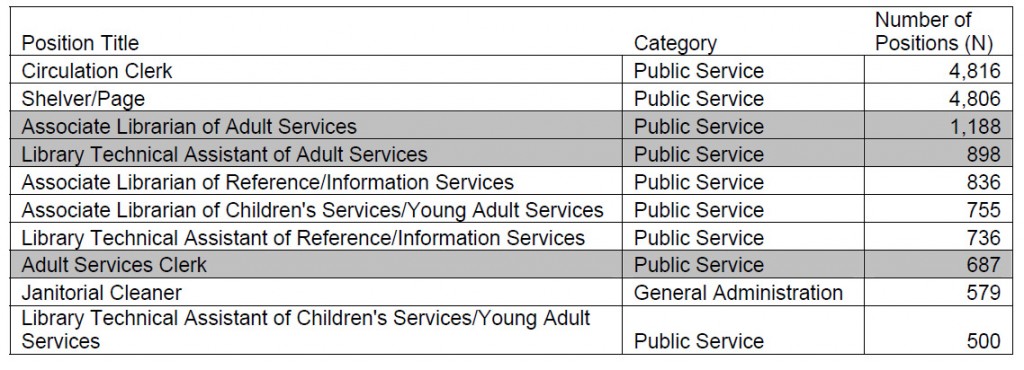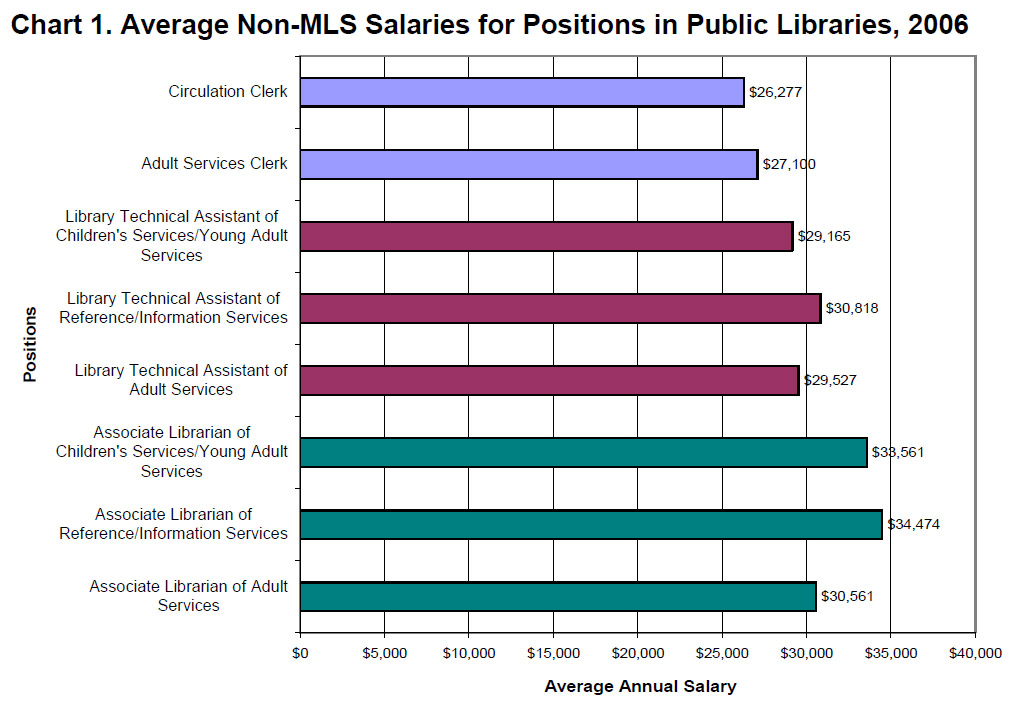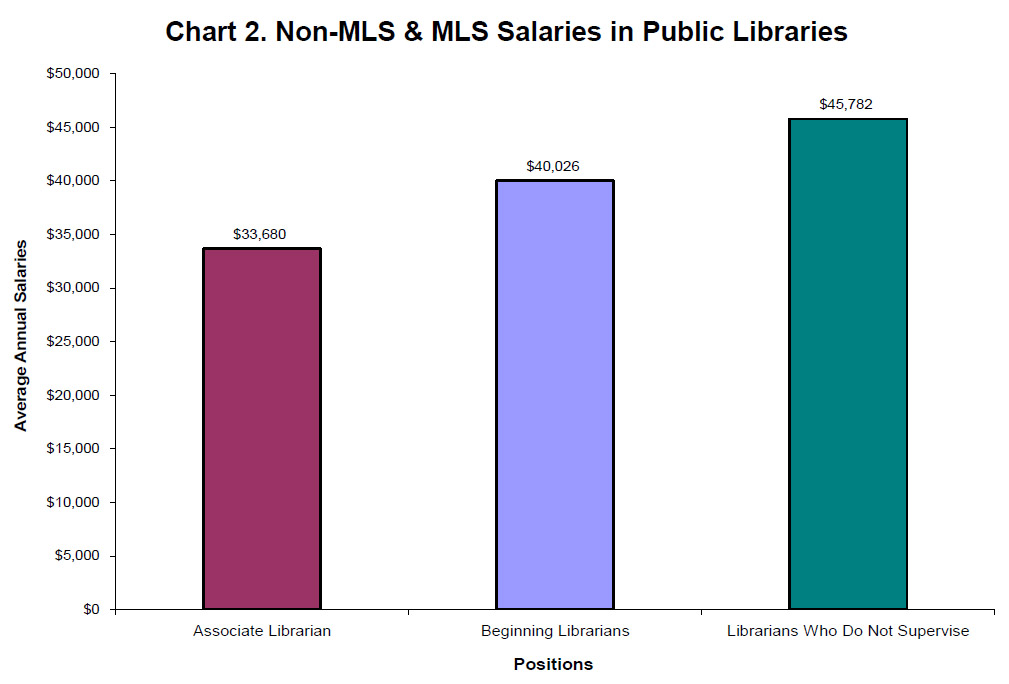Library support staff are a vital part of many public libraries. They can be an integral part of a department’s services for their patrons. The ALA-APA Non-MLS Salary Survey is ALA’s first attempt to collect salary information nationally for all non-MLS staff not included in the ALA Survey of Librarian Salaries. The survey asked participating academic and public libraries for salary information for an overwhelming 62 positions.
For public libraries, 10 of the 62 positions had 500 or more responses (see Table 1). Of these 10, 9 were in the Public Service category. Furthermore, Adult Services was the only department to have all 3 position levels (Clerk, Library Technical Assistant, and Associate Librarian) represented in this high response group. (See definitions below for the position levels.)
Associate Librarian (non-MLS degreed) – Provides assistance to patrons including topical research and material location. Assists patrons with the use of library resources and equipment. Screens the collection for outdated or unused materials following established guidelines. May perform managerial and administrative duties.
Library Technical Assistant – Provides basic assistance to patrons referring patrons to Librarian for professional assistance. Locates materials and information for patrons. May complete routine copy cataloging. Assists with special programming.
Clerk – Performs routine duties requiring the use of a variety of forms, reports or procedures. Provides basic patron assistance: sets up computer stations, locates materials, provides information. Maintains department or area records. Performs miscellaneous clerical duties such as filling, typing, sorting, or photocopying.
Unlike the previous issue of Fast Facts, “Non-MLS Salaries in Academic Libraries Wide Ranging,” there is no clear salary discrepancy specifically for staff in Adult Services when compared to their peers. In fact, the results indicate that Adult Service Clerks have a higher average annual salary than Circulation Clerks—a difference of $823 (see Chart 1).
The average annual salary of Library Technical Assistants (LTA) of Adult Services falls in the middle when compared to their peers. On average, LTAs of Reference/Information Services earn $1,291 more than those in Adult Services, while LTAs of Adult Services earn $362 more than those in Children’s Services/Young Adult Services.
The results for Associate Librarian of Adult Services, on the other hand, show a lower average annual salary than their peers. The average Associate Librarian’s salary is $33,561 for Children’s Services/Young Adult Services and $34,474 for Reference/Information Services. Therefore, the average annual salary of Adult Services (29,527) is between $3,000 and $3,913 less than their peers.
Findings for public libraries are similar to those in academic libraries. Results from both library types indicate that salaries of Associate Librarians (non-MLS) are catching up to salaries of Beginning Librarians (MLS), as reported in the 2006 ALA-APA Non-MLS Salary Survey. Also, the number of positions reported in both surveys indicates there may be more Associate Librarians than Beginning Librarians working in public libraries.
The average annual salary for all types of Associate Librarians in public libraries is $33,680 and the average for Beginning Librarians is $40,026 (see Chart 2). Therefore, Associate Librarians (non-MLS) earn only $6,346 less than Beginning Librarians (MLS). This is a greater difference than the one between Beginning Librarians and Librarians Who Do Not Supervise (that difference is $1,650). Notably, however, there are fewer reports of Beginning Librarians salaries than Librarians Who Do not Supervise and Associate Librarians. While the MLS survey received 1,650 responses for Librarians Who Do Not Supervise, the survey only received 311 for Beginning Librarians. The Non-MLS survey received 3,416 responses for Associate Librarians.
To conclude, the data suggests that although non-MLS staff in Adult Services may not always earn the highest average annual salaries compared to positions in other departments, their salaries are still competitive with their peers in positions at similar levels. This may indicate that public libraries recognize the need to retain well-trained and experienced staff in support positions.
On the other hand, a comparison of Beginning Librarian (MLS) and Associate Librarian (non-MLS) salaries, suggests a lack of recognition for Beginning Librarians. Based on the data, it appears that public libraries employ Associate Librarians (non-MLS) 10 times more than Beginning Librarians (MLS). The salaries of Associate Librarians are also closing in on Beginning Librarians. It is encouraging to see public libraries recognize the value of non-MLS staff by providing competitive salaries. However, if this is truly the case, libraries need to also recognize the importance of the Beginning Librarian position in order to retain qualified professional staff for the future.
Sources
- Grady, J. & Davis, D. (2006). ALA-APA Non-MLS Salary Survey: A Survey of Library Positions Not Requiring an ALA-Accredited Master’s Degree. American Library Association – Allied Professional Association.
- Grady, J. & Davis, D. (2006). ALA Survey of Librarian Salaries. American Library Association – Allied Professional Association.


